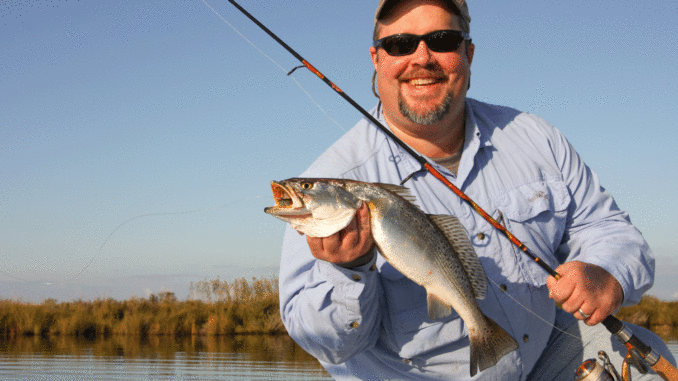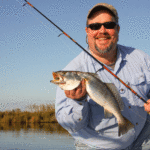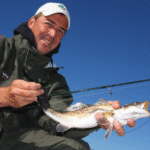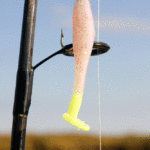
Pay attention to the water movement, particularly on a falling tide, and you’ll catch more speckled trout this winter.
One of the things that most intimidates me about fishing inshore saltwater fish as opposed to freshwater fish is how much more vast the playing field is.
The father of structure fishing for bass, Buck Perry, is famous for stating the obvious: “The bass are either deep, shallow or somewhere in between.”
Inside the confining rim of a reservoir, bass are limited as to where they can be. And all Perry was trying to intimate was that if the fish weren’t biting in one place, there were two others to try.
Take those same bass, however, and put them in the marshes around Delacroix Island. Bass could still be deep, shallow, or somewhere in between, but they could also be over here or over there.
So many more places to fish makes finding and catching speckled trout more of a challenge in a coastal saltwater fishery. I guess that challenge might be offset some by the greater number of trout than there would be bass and their propensity to stack up in the same places year after year.
But if you don’t spend enough time on the water to figure out where trout like to frequent, you can find yourself at a loss as to where to fish. You could pull up to any point, drain or pocket, or you could do what Capt. Chris Pike (504.427.4973) does — drift fish tide lines.
“Trout school up down here in the interior bays like Four Horse, Skippy Lake, Little Four Horse and Lake Batola,” Pike said. “In those lakes, find the drains coming out of the marsh on the north side that is protected, and drift the tide lines coming out of those drains during a falling tide.”
With so much water to eliminate, Pike believes these tide lines are perfect spots for anglers looking to quickly get on a bunch of fish because they are so easy to find. Marsh grass filters the water as it falls out of the marsh, and this creates a distinct sliver of clear water that cuts into the muddier water in the lakes and bays.
Once the tide starts falling, Pike says the trout bite can be good as long as it continues to fall. In fact, this is one of the reasons he fishes during the middle part of the day during winter. Playing the falling tide sometimes gives him as much as six or seven hours of excellent fishing.
While these tide lines may not look that dynamic at the surface, Pike says they are a perfect combination of bait concentrated in a place where trout can easily pick them out.
“All that clean water coming out of the marsh is full of bait,” Pike said. “It’s mainly pogies with a couple leftover shrimp and some cocahoes. But you can tell it’s mainly pogies because you can see them flipping on the surface.
“Anytime you see bait doing that, or you hear that clicking noise pogies make when they flip, you can bet trout are chasing them.”
However, anglers don’t even have to be astute enough to see bait or clear water to find productive tide lines. Pike says that when the water falls out of the marsh, it creates a few other easily identifiable features.
Many times, these tide lines are given away by the presence of foam on the surface or bits of broken grass moving along in the current. Where you see either of these two features extending out in some semblance of a line from a cut, you can bet you’ve found a good tide line.
“And when you find a good tide line,” Pike said, “pay attention to the line where the clean water meets the dirty water. That’s the line you want to fish.
“I set up maybe 10 or 20 yards in the dirty water and cast into the clean water. You’ve got about 15 feet or so to play with on either side of the tide line, but most of your bites will come on the clean-water side.”
And Pike cautioned about just running up to a drain where you’ve found a tide line and fishing only the mouth of the cut where the water is coming out. Many of these tide lines can extend out upwards of 200 or 300 yards away from the bank, and trout could be positioned anywhere along that line.
One of the best spots along a tide line, according to Pike, is the area where the clean water mixes into the muddier water on out in the lake and the line kind of disappears. There’s so much water coming from so many directions in these “mixing holes” that lots of bait is churned up.
“Trout sit out there around those areas because there’s not as much flow, and the bait it so easy to catch,” Pike explained. “If you don’t drift out and fish these spots before you run off to find another tide line, you’re missing out on some of the best fishing these kinds of spots have to offer.”
Another of Pike’s keys to catching a lot of trout off the tide lines is to look for those that have some kind of obstacle in their way. Anything that breaks up the flow of the water could potentially have hundreds of trout stacked up behind it.
“A stump, a patch of grass — anything that will create a pocket of slack water behind it,” Pike said. “Trout get in that slack water and just wait on the bait to be washed to them.
“That’s the kind of places where they can really school up.”
Among the most overlooked pieces of structure, in Pike’s opinion, are the buoys that mark crab traps. While they may not look like much on the surface, Pike says they offer just enough to attract lots of trout.
These buoys will obviously be pulled in the direction of the current, and most of them are covered in baitfish-attracting algae on the half that spends all of its time in the water. Baitfish frequently ball up behind these buoys, and that only serves to ring the dinner bell for hungry trout when the water starts falling.
“Depending on the wind, which is usually from the north in December, I like to fish the tide lines by starting at the opening of the drain and drift with the wind and current as far as it will push me,” Pike explained. “If it doesn’t push me all the way to that mixing area, I’ll drop the trolling motor and troll on out to it.”
Pike keeps it pretty simple when fishing tide lines during the winter. He selects either an opening night- or glow-colored 3-inch Marsh Works Bayou Thumper plastic minnow, and he likes to hand dip the tails chartreuse. Either of these he fishes about 18 inches under a clip-on popping cork.
“You might not think it makes that much difference, but I’ve been outfished 15 to 1 before in the winter by somebody throwing a clip-on while I tried the pre-rigged corks with the wires through them,” Pike insisted. “I think the ones with the wires make just a little bit too much noise for wintertime fishing when everything is kind of lethargic and not as active.
“I think the clip-on corks make more of a true sound of a fish hitting the surface when it’s cold.”
Pike selects opening night or glow because they imitate the two main forages trout eat during the winter. The opening night resembles pogies, and the glow is a dead ringer for the white shrimp that are still in the marsh.
However, if you can get live shrimp, which Pike says you should be able to do at Sweetwater Marina, it’s good insurance to take them along with you. One of the techniques Pike likes to employ to maximize the numbers of fish for his anglers is to get the trout going on plastics and then switching to the live shrimp to really slam them.
“One of the techniques I really like to use is to pop my cork as soon as it hits the water to get the fish stirred up quickly, and I think a spinning reel with its much higher gear ratio allows me to do that without missing as many fish,” Pke said.
Pike also reasoned that spinning reels allow him and his anglers to make longer casts into winter winds without any of the backlashes or trouble presented by baitcasting reels to untrained thumbs.
Winter takes out at least part of the possibilities for speckled trout because we know they’re going to be on the inside. That narrows it down to deep, shallow, somewhere in between, over there or over here. But that’s still a lot of intimidating possibilities.
Do like Pike does, though, and fish the tide lines during December at Delacroix. Then there’s no doubt where the trout will be — in your boat.



